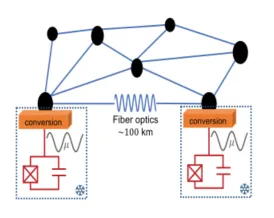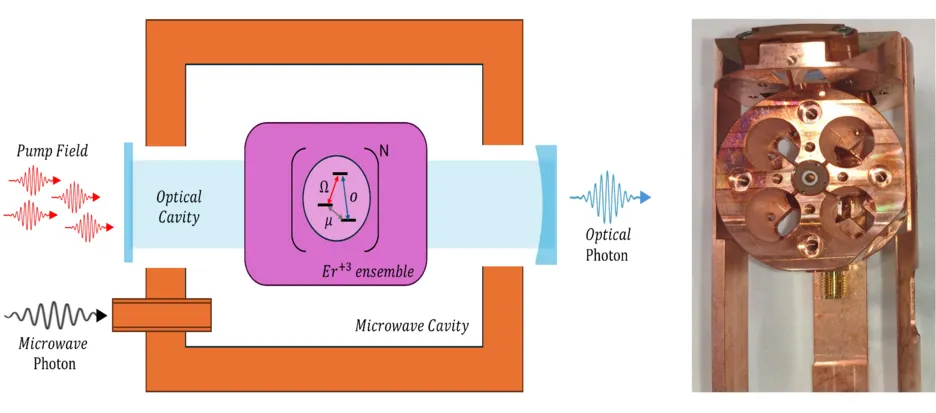Superconductive qubits are among the most developed platforms when it comes to quantum computing, however, due to their operating frequency, microwave photons are not able to propagate. The development of a device capable of converting microwave photons to optical photons at telecommunication wavelengths would be a key enabler for the communication between remote quantum computers [1].
Erbium ensembles are promising materials in this context, as they exhibit both microwave and telecom transitions, making them effective as a nonlinear medium for an efficient Raman conversion process [2]. We are exploring two distinct systems on different platforms:
First, we investigate materials with a low concentration of erbium dopants that are well-understood and can have well-suited optical and microwave properties for efficient transduction. We plan to implement this system in two different platforms: erbium ensembles doped into nanophotonic silicon waveguides and erbium doped crystals. The former features a unique combination of a small inhomogeneous broadening and an exceptional optical coherence, even in nanostructured materials, while the latter can exhibit remarkable spin coherence depending on the host crystal. In both cases, we plan to integrate the Erbium into resonators with high quality factor for both optical and microwave transitions. Compared to recent efforts that have achieved efficiencies of approximately 10-7 [3] and 10-5 [4] in respective approaches, we study which improvements can be expected from higher-Q resonators, optimized geometry and different host crystals.
Second, on the other end of the concentration scale, we explore stoichiometric crystals, in which erbium is integrated as part of the lattice and not as a defect. This results in a high concentration of erbium spins without compromising the inhomogeneous broadening. At temperatures below 0.1 - 4 K, these crystals exhibit long-range order, typically antiferromagnetic, and display magnon modes that can be used for transduction. However, even though they have shown interesting properties like very narrow transitions, the spectroscopy of these materials is still at an early stage.
The goal is to achieve transduction efficiencies approaching unity with a high bandwidth of several MHz, paving the way for the entanglement of remote superconducting qubits.
References :
[1] Lauk, Nikolai, et al. Perspectives on quantum transduction, Quantum Science and Technology 5.2, 020501 (2020)
[2] L. A. Williamson, et al. Magneto-Optic Modulator with Unit Quantum Efficiency, Phys. Rev. Lett, 203601 (2014)
[3] X. Fernandez-Gonzalvo, et al. Cavity-enhanced Raman heterodyne spectroscopy in Er:YSO for microwave to optical signal conversion, Phys. Rev. A 100, 03380 (2019)
[4] J. Rochman, et al. Microwave-to-optical transduction with erbium ions coupled to planar photonic and superconducting resonators, Nat Commun 14, 1153 (2023)

